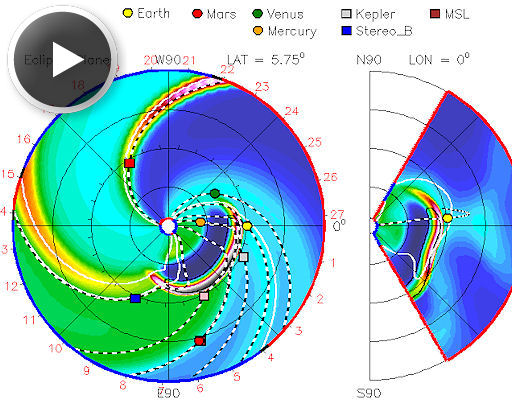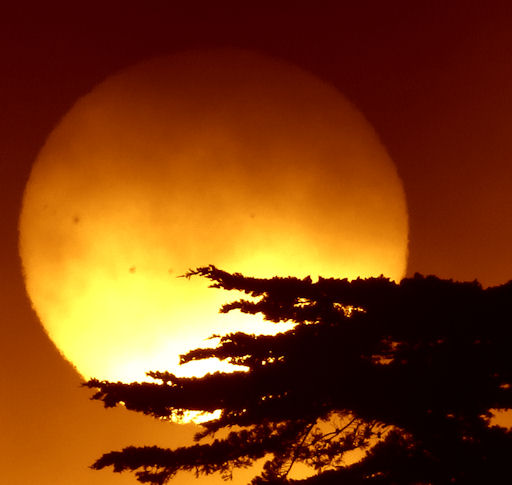MARTIAN TRIANGLE: On the same night Curiosity lands on Mars, a "Martian Triangle" will appear in sunset skies of Earth. The first-magnitude apparition on August 5th gives space fans something to do while they wait for news from the Red Planet. [video] [story]
INCOMING CME, WEAK IMPACT EXPECTED: A coronal mass ejection (CME) produced by Saturday's M6-class flare is heading toward Earth. According to analysts at the Goddard Space Weather Lab, the cloud could deliver a glancing blow to our planet's magnetic field on July 31st around 1500 UT (+/- 7 hours). Click to view the animated forecast track:
This is a slow-moving CME. The cloud's low speed (382 km/s estimated) combined with its glancing trajectory suggests a weak impact is in the offing. Nevertheless, polar geomagnetic storms are possible when the cloud arrives. Aurora alerts: text, voice.
The CME will also hit Mercury, probably with greater force. Mercury's planetary magnetic field is only ~10% as strong as Earth's, so Mercury is not well protected from CMEs. When the clouds hit, they can actually scour atoms off Mercury's surface, adding material to Mercury's super-thin atmosphere and comet-like tail.
Realtime Space Weather Photo Gallery
FOGGY SUNSPOTS: Living in a fog can have its advantages. For one thing, it allows you to see big sunspots. Mila Zinkova of San Francisco, California, sends this picture of the foggy sunset on July 28th:
The tree limbs point across the solar disk to sunspot group AR1532, the source of at least one M-class solar flare per day since Friday. NOAA forecasters estimate a 25% chance of additional M-flares during the next 24 hours, although the actual odds seem higher. More flares (and more spotted sunsets) are in the offing. Solar flare alerts: text, voice.
![]()

![]()
Solar wind
speed: 434.2 km/sec
density: 0.5 protons/cm3
explanation | more data
Updated: Today at 1646 UT
![]()
X-ray Solar Flares
6-hr max: M1 1548 UT Jul30
24-hr: M1 1548 UT Jul30
explanation | more data
Updated: Today at: 1600 UT
![]()
![]()
![]()
Daily Sun: 30 Jul 12
![]()
![]()
Sunspot AR1532 poses a growing threat for M-class solar flares. Credit: SDO/HMI
![]()
![]()
![]()
Sunspot number: 79
What is the sunspot number?
Updated 29 Jul 2012
Spotless Days
Current Stretch: 0 days
2012 total: 0 days (0%)
2011 total: 2 days (<1%)
2010 total: 51 days (14%)
2009 total: 260 days (71%)
Since 2004: 821 days
Typical Solar Min: 486 days
Updated 29 Jul 2012
The Radio Sun
10.7 cm flux: 123 sfu
explanation | more data
Updated 29 Jul 2012
![]()
![]()
![]()
Current Auroral Oval:
Switch to: Europe, USA, New Zealand, Antarctica
Credit: NOAA/POES
![]()
![]()
![]()
Planetary K-index
Now: Kp= 3 quiet
24-hr max: Kp= 3 quiet
explanation | more data
![]()
Interplanetary Mag. Field
Btotal: 7.7 nT
Bz: 5.7 nT south
explanation | more data
Updated: Today at 1646 UT
![]()
![]()
![]()
Coronal Holes: 29 Jul 12
![]()
![]()
A solar wind stream flowing from this coronal hole should reach Earth on July 29-30. Credit: SDO/AIA.






